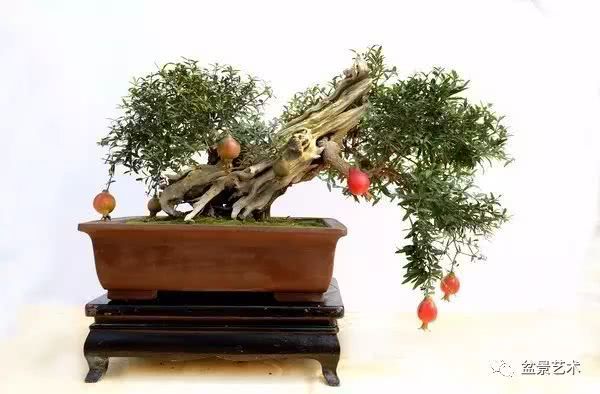Production and maintenance of pomegranate bonsai

The pomegranate flower is big and colorful, and the flowering period is long. From before and after wheat harvest to October, the pomegranate fruit is gorgeous in color. Because of its ability to enjoy flowers and eat fruits, it is deeply loved by people. Bonsai made of pomegranate is even more popular.
(a) selection of varieties and flower pots. To view flowers mainly, should choose large flowers, bright color, multi-petal varieties, such as large flower pomegranate or peony pomegranate, etc.; to view fruit mainly, you can choose beautiful fruit red varieties, such as Taishan red pomegranate, etc., can also be determined according to personal preferences or needs. Flower pot selection to clay pot is good, because of its good drainage ventilation, conducive to pomegranate growth, its shortcomings are not very beautiful, easy to damage, and plastic pots, enamel pots and other beautiful appearance, a variety of patterns, but poor ventilation drainage, optional. The size of the pot depends on the size of the seedlings.
(2) preparation of culture soil. Potted pomegranate soil, loose ventilation requirements, fertilizer storage, nutrient-rich. 3 parts of garden topsoil, 3 parts of decayed leaf soil, 2 parts of manure and 2 parts of fine sand can be mixed evenly, or 1/3 of horse manure, garden soil and fine sand can be mixed into culture soil, piled up and covered with plastic film tightly, sterilized at high temperature for 15- 20 days, sieved and put into pots.
(3) Planting in the upper pot. Before budding in spring, cover the bottom drain of the pot with tiles, then fill it with soil, about 2/3 of the pot, and form the mound into a mound. Select complete root system, fibrous roots, good tree seedlings, root system stretch into the pot, continue to load soil, while loading soil will gently lift seedlings upward, so that the root system and soil close contact. Pot soil should not be overfilled, rhizomes and soil surface level, soil compaction, irrigation through water, water infiltration, with dry soil cover surface moisture, placed in the shade, generally do not water before germination to facilitate warming rooting.
(4) the modeling and production technology of bonsai. Bonsai according to its material selection and processing methods are different, mainly divided into tree stump bonsai and landscape bonsai two categories. For example, Zaozhuang Yicheng pomegranate bonsai is mainly based on stump bonsai, which takes pomegranate trees as the main body, sometimes also uses rocks as lining to make elegant and peculiar pomegranate bonsai, mainly to watch the various shapes of pomegranate trees and the characteristics of stems, flowers, fruits and branches and leaves. Through artistic processing and careful cultivation such as carving, tying, twisting, pruning, picking, bud wiping, peeling, cutting, bending, etc., the growth and development are controlled for a long time, resulting in a pomegranate bonsai that is close to the mountain forest and old and simple.
(v) Management techniques
1. Branch management. When the new shoots grow to 10--15cm, they should be removed in time to control the length and promote flowers; the adventitious buds sprouted at the trunk, main branch and rhizome should affect the modeling and ventilation. In order to dwarf the tree, in the long period of vigorous new shoots, 200 times of 15% paclobutrazol solution can be sprayed for 2- 3 times, which is conducive to controlling the length and promoting flowers, and can achieve the effect of shrinking dragons into inches.
2. Fertilization. Pomegranates like fertilizer, planting to apply sufficient base fertilizer, growth period of each phenological period, to supplement the nutrients needed for plant growth. Nitrogen fertilizer is mainly used in spring, phosphorus and potassium fertilizer is mainly used in autumn, or soybean cake, chicken and duck dung are used to prepare sufficient decomposed solution for irrigation, and foliar fertilizer is sprayed for 3- 5 times in the growth period, and potassium dihydrogen phosphate solution with a concentration of 0.3%-0.5% is sprayed to supplement soil fertilization.
3. Watering. pomegranate tree is a drought-tolerant species, water trees easy to grow, generally do not dry irrigation, watering is to irrigate thoroughly, not after the rain fertilization, fertilization must be watered. During flowering and fruiting period, keep proper drought to prevent flower and fruit drop.
4. Flower management. Pomegranates like sunny and warm environment, the minimum number of light hours per day to bloom in more than 4 hours, in the entire growth period, flowerpots should be placed in sunny and ventilated places. Flower bud differentiation period, to keep the basin soil appropriate drought, conducive to flower bud formation. Flowers should avoid spraying as much as possible, in order to improve the fruit set rate, can spray 0.3% borax solution in flowering, or artificial auxiliary pollination. The method is that before 10:00 a.m. every day in florescence, the bell-shaped flowers that have completely opened are picked, and the stigmas of the aligned tubular flowers are gently tapped. Each bell-shaped flower can be awarded 15- 20 tubular flowers, and the fruit setting rate can be increased by more than 50%. Other cultivation management and pest control can refer to field management.
- Prev

The younger sister sat on the moon and the elder brother went to visit the door and saw everyone eating. He took his sister away.
(from the reader's contribution, the picture of this article is from the Internet) my sister sat on the moon, my brother went to visit and saw everyone eating. He took my sister away. In my opinion, there is nothing more important than blood than water, but I only.
- Next

Auntie, don't try to get back together with your daughter. Let her live with her new husband.
(from readers, pictures of this article are from the Internet) Auntie, don't try to get back together with your daughter. Let her live with her new husband. If there is no comparison, there will be no gap and no harm. Whether it's a person or a thing, you have to find it.
Related
- Wuhan Hospital Iron Tree Blooming Result Was Instantly Frightened by the Gardener Master
- Which variety of camellia is the most fragrant and best? Which one do you like best?
- What is the small blue coat, the breeding methods and matters needing attention of the succulent plant
- Dormancy time and maintenance management of succulent plants during dormancy
- Minas succulent how to raise, Minas succulent plant pictures
- What are the varieties of winter succulent plants
- How to raise succulent plants in twelve rolls? let's take a look at some experience of breeding twelve rolls.
- Attention should be paid to water control for succulent plants during dormant period (winter and summer)
- Watering experience of twelve rolls of succulent plants
- Techniques for fertilizing succulent plants. An article will let you know how to fertilize succulent plants.

